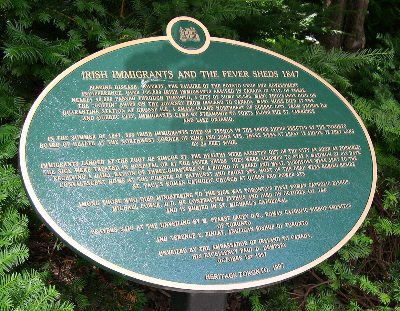Located in a six-acre block at the north-west corner of King and John Streets, York General Hospital was the first hospital in York founded specifically to treat civilians. Its establishment was the result of efforts of the doctors and the public.
The first medical practitioners in York were the military surgeons. Early civilian doctors found it difficult to make a living as physicians in York Township with its much poverty and a scanty population. Dr. William Baldwin, earned a living as a lawyer, but did open a free clinic for the impoverished Irish who were carriers and sufferers of epidemics. Dr. John Rolph pushed for a medical school and eventually set up his own in Yorkville. Frequent epidemics and other medical problems made the need for doctors and a hospital serious. While the 1797 Plan of the Town of York had been set aside a six acre block for a hospital, it was never used. The Loyal and Patriotic Society of Upper Canada raised money for medals for the veterans of the War of 1812, but decided that a brick hospital was a greater need. The hospital was finished by contractor John Ewart in 1820, but was temporarily occupied by the government, because the new parliament building replacingbthose burnt by the invading American Army, had also been destroyed by fire. This kept the hospital from opening until 1829, when it started operations by treating an epidemic of measles.
By the 1850s it was obvious that it was not large enough, so a campaign was launched to build a replacement. In 1854, the hospital was closed, its site cut up into lots. The replacement on Gerrard Street opened two years later as Toronto General Hospital.

Fever Sheds
An 1842 map shows that this block, where the hospital existed, also contained an Emigrant Building. The Irish, fleeing from the potato famine and other misfortunes, were not warmly welcomed in Toronto. The ships that brought them to Canada had appalling conditions and most arrived very unhealthy. They carried cholera and other diseases. To cope with this and the want of proper sanitation, the city passed sanitary regulation in June 1847. Quarantine sheds. The first in the city, were established at the north-west corner of King and John for cholera. Other sheds set up near Bathurst for typhus. As the health problems and numbers of immigrants kept growing, other sheds were built. Some were housed in shanties, boarding houses and even hotels. In the late 1850s, German, Scandinavian and other immigrants arriving by boat generally went on by train to other places. About half the Irish stayed, to poor to proceed farther, but others continued on to the United States. While the Irish suffered terribly from cholera, not all cholera epidemics can be blamed on the Irish. The real lack of proper sanitation systems in the city was a major factor in the spread of cholera and other plagues. The above plaque in remembrance of this part of Toronto’s history can be found between the north entrance to Metro Hall and King Street. .
Information from “A Glimpse of Toronto’s History” (MPLS # 132 and 133)
